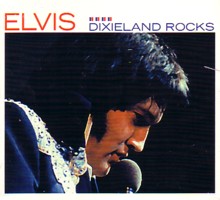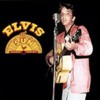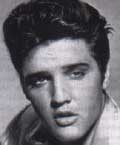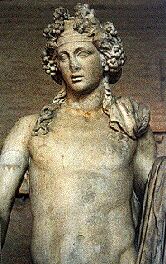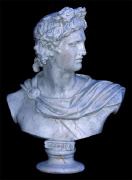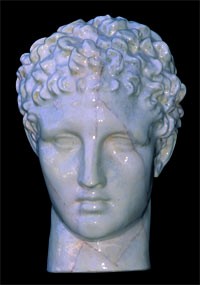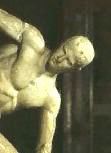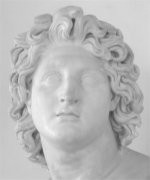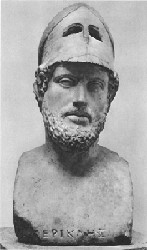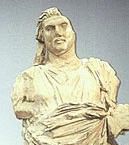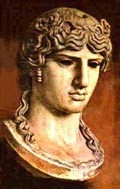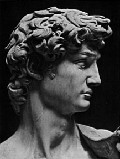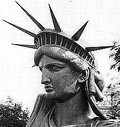Elvis
Presley: Hero with a Thousand Faces
by
Susan MacDougall
National
Elvis Presley Conference, Canberra, Australia, November 2004
SUMMARY
This
paper explores the notion that Elvis Presley is becoming semi-divine
by comparing his life story with those of legendary and mythical
heroes, and other archetypal beings. Presley appears to fit
more than one archetypal pattern of the mythical hero/king/god.
His features even resemble some of the ancient ones, as depicted
by statues.
INTRODUCTION
We
live in exciting times. We may well be witnessing a beloved
idol on the way to becoming sem-divine. Elvis Presley is already
a saint-like figure to many, as witnessed by the prevalence
of "Elvis shrines" and the pilgrimage to Graceland. The myth
is growing.
Myths
and legends are based on archetypes. These are frequently
used by authors writing modern fantasy fiction of epic proportions.
But "mythic structure" is more than the underlying archetype
of a good story: myth teaches people how to discern good and
bad, right from wrong, and how to order their lives - that
is, it is a moral story. This is why the accepted myth of
Elvis as a pop star who rose too high too fast and had a mighty
fall is so prevalent and acceptable. His is a cautionary tale
about the pitfalls of fame and fortune.
There
are various archetypes based on the "myth of the hero": they
include Central Asian and Roman and Greek kings and heroes;
British heroes such as King Arthur; the fairytale prince;
and, more recently, superhero models. While some may think
it is far-fetched to compare a pop singer to heroic archetypes,
it is undeniable that a myth is developing around Elvis Presley.
There may be some powerful psychological reasons why some
people are elevating him to god-like status.
The
world needs larger-than-life heroes, and Presley appears to
meet that need. We shall compare the Elvis Presley story to
several archetypes, to see how he fits the pattern. Archetypes
are universally understood pattern of behaviour which recur
in myths and legends, linking them across time. Definitions
of other terms used in this paper can be found in Appendix
1.
ABOUT
ARCHETYPES
There
are archetypes for human thought and deeds, as well as for
faces and figures. In this paper we will look at the theories
of psychologist Carl Jung and anthropologist Joseph Campbell
regarding archetypes and myths. While Jung's theories are
not universally accepted, we will nevertheless explore his
ideas in the hope that they may provide fresh insight into
the Elvis Presley phenomenon. Jung identified many different
archetypal patternings of human thought. These represent ways
of thinking and behaving that humans adopt, many times without
being fully conscious of the pattern they emulate.
Campbell
began a revolution in anthropology with his book The Hero
With a Thousand Faces. This book built on the pioneering work
of German anthropologist Adolph Bastian (1826-1905), who first
proposed the idea that myths from all over the world seem
to be built from the same "elementary ideas". Campbell took
this idea of archetypes and used it to map out the common
underlying structure behind religion and myth. The Hero With
a Thousand Faces provides examples from cultures throughout
history and all over the world.
Campbell's
thesis is that all stories are fundamentally the same story,
which he named the "hero's journey," or the "monomyth." Authors
use the "hero's journey" model for writing fantasy fiction
in the form of secondary epics. Examples of such fantasy fiction
include: Wagner's "Ring Cycle"; Tolkien's "Lord of the Rings";
"Star Wars"; and, "The Matrix" .
EXPLORING
THE ARCHETYPES
The
hero: As already suggested, there are myths with common
themes across cultures and civilisations. These universal
myths cover such topics as life, death, the creation of the
world, the end of the world, and exploits of men and women
(mainly men). Among them is the "myth of the hero". The general
myth concerns a young man, usually a king's son, who is abandoned
but saved from death. He suffers various trials and ordeals.
By overcoming them he transcends the human condition, after
which he belongs to a class of semi-divine beings. Examples
of such heroes are Siegfried, King Arthur and Robin Hood.
The physical journey through life is a metaphor for inner
development. Trials and quests are obstacles to be overcome,
and are the means by which the hero achieves self-integration,
balance, wisdom and spiritual health.
Similarly,
John Bunyan's The Pilgrim's Progress, written in the 17th
century, is an allegory of the pilgrim's journey to salvation,
representing his spiritual development. Tolkien believed that
the point of myth is to portray a hero figuring out the difference
between right and wrong, which prepares the reader to make
the same heroic journey in their own life . The earliest recorded
myths embodied divinity as a pantheon of gods, and evil as
disobeying the will of the gods. Often the embodiment of disobedience
was the father-god's ugly, handicapped or otherwise disadvantaged
younger son, who rebelled out of jealousy of the older, handsomer,
more capable son who would one day rule the gods . (Of course,
such attitudes towards disability and disadvantage are now
considered unacceptable and discriminatory.)
Hero
myths tend to stem from times of trouble, especially invasion.
The Arthurian myth became prevalent in the Middle Ages, based
on events in the 5th or 6th century when post-Roman Britons
were attempting to stave off conquest from continental invaders.
Arthur was a Roman-Briton fighting the Angles, Saxons and
Jutes. The Robin Hood myth places Robin in the early 13th
century at the time of King John, although he was, in fact,
late 14th century. Hereward the Wake was another hero who
fought for the Saxons against their new masters, the Normans,
after their invasion of Britain.
These
"popular hero versus the oppressors" myths brings hope in
troubled times . While some heroes emerge to combat a specific
threat, such as Arthur, Robin Hood or Beowulf, others were
more generalized images of the better qualities of humanity:
Heracles (Roman 'Hercules') and his legendary labours were
both the actions of a hero in combating monsters and acts
of redemption: Heracles accepted the labours to redeem himself
after killing his family in a fit of divine-inspired madness.
If he could become a hero after so heinous an act, then ordinary
man could also be saved.
The
Flawed Hero: We find that many heroes were flawed, and
their heroism, despite their faults, was often a theme of
their myths. For example, the Babylonian Gilgamesh myths have
King Gilgamesh beginning as a tyrant. The Gods send Enkidu,
a wild man, to destroy Gilgamesh but the two become friends
and share adventures until Enkidu's death.
Madeleine
Wilson compares Elvis to the Biblical Samson, a Nazirite and
judge renouned for his physical strength . He destroyed God's
enemies, but because of moral weakness, he lost his strength,
was captured, blinded, and reduced to being mocked in front
of his enemies. Through his death, however, he destroyed more
of God's enemies than when he was alive.
The
King: There are a couple of king archetypes which we can
use for comparison with Elvis Presley. Some of them echo the
"flawed hero" theme.
The
Mystical King with Healing Powers King Arthur is the obvious
example of a legendary king with mystical healing powers.
The
Arthurian/Celtic cycle provides a classic example of the shadow
archetype (explained in Appendix 2) as a reflection
of the hero and dark side of humanity. Mordred is a reflection
of his uncle (in some variants of the myth, father) Arthur
and represents directly Arthur's dark side. When Arthur kills
Mordred, and is in turn fatally wounded, he is not only good
defeating evil, but also a good man defeating his own dark
thoughts and dark actions .
The
Wounded King: The "Elvis ~ A Lighted Candle" web site
proposes that Elvis's greater overall archetypal role is that
of the "Wounded" or "Lame" King, also based on King Arthur.
The wounded king is generally considered to be the guardian
of the "Holy Grail consciousness", but is not adequately empowered
to carry out the job. The Wounded King must be healed, but
this not possible until the rightful recipient of the "Grail
consciousness" comes along and claims the Grail. This is Perceval,
who asks the right questions about the king's wound, the bleeding
lance and the grail, at which the king is cured. Perceval
succeeds the old king, takes on his powers, and becomes King
of the Grail.
Taoist
king: Another way of looking at the king archetype, again
with particular reference to Presley, is from a Taoist viewpoint.
Rosen,
in The Tao of Elvis, illustrates Elvis's Taoist nature and
interprets his never-ending search for purpose and meaning.
The book highlights Elvis's journey from light into dark,
focussing mainly on the double-edged quality of the king archetype
- how it can function either as a channel to the divine or
a destructive mechanism for the one who tries to live it out
in human form. While Elvis may not have achieved transformation
or "wholeness" (in the Jungian sense) in his lifetime, there
is a possibility of redemption for Elvis and for us.
"We
can, in a sense, make him whole by finding meaning in his
suffering (something he was not able to do himself). ... Our
awareness of our own weakness and vulnerability is the fountainhead
of empathy. Elvis had this awareness (at least some of the
time) along with a great capacity to care for others."
Rosen
says that Elvis failed to transform his 'false king self'
into his 'true creative self'. Here is another, related, quote:
"Elvis, like a giant mirror, reflects our own struggles with
forces of good and evil, and creation and destruction. In
a real way, when we see Elvis we see ourselves. Symbolizing
the battle between the true and false selves in us all, Elvis's
huge appeal lies in his power as an archetype - his epic rise
and fall captures what is in all of us. Through understanding
the Tao of Elvis, we can come to better understand ourselves.
"
The
Saviour: The tendency to deify Elvis (along with George
Washington) reveals the operation of the saviour archetype,
a seemingly innate psychological disposition to attribute
divine attributes and powers to great religious leaders or
other prominent figures. There are significant parallels in
accounts of the alleged saviours in the world's religions,
concerning the saviors' attributes, experiences, and plans
for human redemption.
| The
conditions listed below have been identified on the "Saviour
Archetype" site as the most distinctive conditions for
being a saviour. They occur to varying degrees in various
religions. The saviour's birth and life are foretold in
prophecy; the saviour has a miraculous birth; the saviour
has a royal genealogy; the saviour is threatened in infancy;
the saviour is tempted by demons; the saviour works miracles;
the saviour is a deity with a triune nature; - Chritianity;
Buddhism's "three manifestations or bodies"; Zoroastrian's
masculine and feminine trinities; the three Greek/Roman
gods Zeus, Hades and Pseidon) the saviour offers redemption
through grace; there is a baptism of water; - Christianity;
Hinduism there is a communion of bread and wine (water);
- Christianity; Judaism; Mithraism; sacred meals of bread
and wine were also taken in the rites of Dionysos (see
photo opposite), Orpheus, Cybele, and Attis the saviour
condemns those who do not believe (or who lead sinful
lives); the saviour transfigures himself; and, the saviour
rises from the dead and ascends into heaven. |
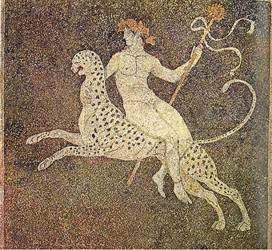 |
Relating
the saviour archetype to fantasy fiction, it appears that
Tolkien's The Return of the King was probably inspired by
the legend that King Arthur, like Christ, will one day return
to reward good and punish evil. The Return of the Jedi also
echoes this title . Rosen remarks on the spiritual side of
Elvis: "Elvis was on a spiritual quest, which is surely related
to his later being seen as a religious figure.
His
favorite songs were gospel, and central to his spiritual life
were the books The Prophet, The Impersonal Life, Autobiography
of a Yogi, and the Holy Bible. He also practised meditation
and belonged to a world-wide yoga organization, the Self-Realization
Fellowship." There is no denying that religious parallels
are emerging concerning Elvis, although his life story does
not fit the saviour archetype. He does set out on a spiritual
journey in parallel to his career. He does suffer various
trials and tribulations, challenges and set-backs on the way.
According
to the "Saviour Architype" web page, "Elvis devotees have
apparently predicted that Elvis will come back from the grave
and sing again - maybe Elvis sightings echo the concept of
the hero's return". Whether this prediction is factual or
a facetious invention of the author's is difficult to determine.
But actually, during his lifetime Elvis was credited with
at least one possible healing or faith cure, and since his
death he has been reported to have appeared to people in time
of need and helped them. Furthermore, the numerous sightings
since Elvis's death can be divided into two kinds: "Live Elvis"
and "Spirit Elvis".
"Live
Elvis" sightings perpetuate the lore that Elvis is still alive,
while "Spirit Elvis" stories involve elements of magic, instruction
and healing, and elevate Elvis to a figure of myth and miracle.
"They conform to the framework of folklore" - that is, they
fit an ancient archetype.
The
Fairytale Prince: Yet another version of the mythical
hero is present in fairy tales which tell of an untried youth
in humble circumstances going out into the world to seek his
fortune. He may have royal parentage without knowing it. He
eventually wins the hand of a princess in marriage and rule
over half a kingdom. But first he must undergo a succession
of tests and quests.
"In
Jungian terms, fairytales are "the purest and simplest expression
of collective unconscious psychic processes." Elvis is a good
example of the rags-to-riches story, the poor boy who makes
his fortune, becomes King of Rock and Roll and marries a beautiful
"princess". But, in keeping with the modern world, there is
no "happy ever after". His story sets a new model for modern
family break-up, and the perils of fame and drug-taking. So
Elvis fits the old archetype, but at the same time becomes
a new archetype. It is a powerful myth which people want to
believe because it is also a cautionary tale that fits our
era.
|
Superhero:
There are more modern hero myths. Comic book characters
can also conform to the myth of folklore heroes, as
for example, Superman.
In
real life, Superman is a humble person, but is transformed
when the need arises into a superhuman figure who helps
to save the world.
In
the Elvis story, there are also elements of Superman:
offstage Elvis is an ordinary person, but once on stage
in his costume he becomes larger-than-life, assumes
great power and holds sway over vast audiences.
Indeed,
Elvis's childhood comic hero was Captain Marvel Jr.
You can see the resemblance between Elvis's costume
and Captain Marvel Jr.'s.
|
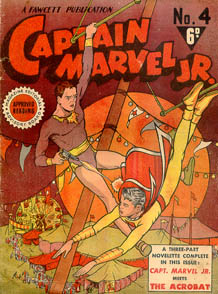 |
The
Hero's Journey: There are several variants to the archetypical
hero's journey. This is Joseph Campbell's version, which can
be used to identify common elements in such epics as Star Wars
and The Matrix:
I:
Departure The call to adventure Refusal of the call Supernatural
aid Crossing the first threshold The belly of the whale
II:
Initiation The road of trials The meeting with a goddess Temptation
away from the true path Atonement with the Father Apotheosis
(becoming god-like) The ultimate boon
III:
Return Refusal of the return The magic flight Rescue from
without Crossing the return threshold Master of the two worlds
Freedom to live The hero's journey does not match the career
path of a twentieth century popular singer very well.
Maybe
we can summarise as follows:
I:
Departure - young
man embarks on singing career
II:
Initiation - young
man shoots to fame. The
road of trials - young
man is vilified in the media and from pulpits; he
is prevented from turning to religion; he
is prevented from touring abroad; his
singing and movie career is stifled. Temptation
away from the true path - young man is sidetracked by the
pleasures of the flesh. Atonement with the father - puts religion
into his concerts.
III:
Return - "Live Elvis" and "Spirit Elvis" sightings; "Elvis
is everywhere".
Faces:
In addition to archetypes for human thought and deeds, there
are archetypes for faces and bodies. Let's have a look at
some faces - and see how Elvis fits in. In fact, if we compare
Elvis's face with those of ancient heroes, kings and gods,
there are some striking similarities.
Two
main archetypal facial forms have been distinguished as being
present in these statues and in their relationship to Elvis
:
1)
Eternal youth and vigor:
Examples:
|
|
|
|
|
Apollo
|
Hermes
|
Discus
Thrower
|
2)
More mature face with a sense of their own power and awareness
of their personal fate
|
|
|
|
|
Alexander
the Great
|
Pericles
|
Mausolus
|
Examples
(above): The shapes of the noses and lips are particularly
striking. The setting of the eyes and the shape of the face
fits to varying degrees. Whether or not heroes and kings actually
looked like their representations, they display the ideal
of beautiful features of their era. Elvis certainly seems
to have conformed to the ideal of Greek beauty.
We
can make other comparisons too :
|
|
|
|
|
Antinous
|
Michelangelo's
David
|
Statue
of Liberty
|
According
to the Lighted Candle web site, Elvis's photographs were used
as studies to re-build Old World statues damaged during the
bombings of WWII.
ARCHETYPAL
ELEMENTS
Some
of the archetypal elements listed in the Appendix resonate
in the story of Elvis's life. The shadow, for instance, brings
to mind these words from the song "And I Love You So": "Shadows
follow me, And the night won't set me free."
Then,
there is the protective and nurturing mother, and the maiden
who is to be protected from monsters and shadows, but who,
because of flaws, may cause the destruction of the hero. Certainly,
Priscilla was involved in the burning of Elvis's religious
books in 1967, which was a setback to his spiritual journey.
The controlling elements around him did not want Elvis to
become more religious, and Priscilla was probably used by
them.
DISCUSSION
These,
then are the archetypes which have been described in this
paper:
- The
Hero
- The
King
- The
Saviour
- The
Fairytale Prince
- Superman
- The
Hero's Journey
- Faces
Overall,
how does Elvis match up against the myth of the hero? Elvis
matches some elements in most of them. On first sight, the
fairytale prince is the closest, with a modern twist.
Elvis
himself becomes an archetype for the modern day family breakdown
and the dangers of fame and drugs. But also, he was a type
of superman in his own way - an ordinary person who became
larger than life onstage and reached out to masses of people
- and he even had the classic features of ancient statues!
Heroes can have flaws and still find redemption.
While
Elvis does not particularly fit the saviour archetype, the
shrines, pilgrimage and candlelight vigils suggest a strong
religious aura around him. For his part, he did not see himself
as the leader of a new religion or cult, but as a conduit
to existing faiths.
The
Lighted Candle site considers that Elvis best fits the wounded
king archetype: Elvis was inadequately empowered and could
not complete his mission. Rosen, in The Tao of Elvis, also
suggests that Elvis failed to conquer his internal demons
and achieve the necessary transformation or "wholeness", but
that he can be redeemed through his suffering and his empathy
for the suffering of others.
According
to Madeleine Wilson, of the British Elvis Gospel Fan Club:
"His
problem was that he was not fulfilling his destiny. Sometimes
it breaks your heart to know how unhappy he was. Elvis should
have been a preacher. He knew what he was meant to do, but
the pressures on him were so great."
But
did Elvis really fail to fulfill his destiny? That depends,
of course, on what you think his destiny was. Certainly his
career was stunted and stifled by his manager, and Elvis himself
thought he was going nowhere. He failed to find fulfilment
and peace of mind on a personal level. However, if his mission
was to preach and bring people back to spiritual values, then
maybe he did succeed and is still succeeding. He incorporated
preaching into his later concerts, reading the Bible and singing
gospel songs on stage. Even now, so long since his death,
there have been instances of people being drawn to religion
as a result of listening to Elvis's music, especially his
gospel songs.
"We
still create myths and heroes today. We need heroes to look
up to and help us make sense of our own lives. In the USA,
John F. Kennedy was a typical example of the mythologizing
of a human figure: his achievements have become enhanced despite
his failings, and his tragic death sealed the legend. Similarly,
Ataturk in Turkey or Gaddafi in Libya have been mythologized
by their cultures. There are many others. We still need heroes,
and are prepared to forgive their faults in return for their
defeat of shadow, and their presence as beacons of hope."
CONCLUSION
The
Presley story is particularly powerful because it fits the
"myth of the hero" archetype in more ways than one - the "rags
to riches" fairytale prince, the power/powerlessness of Superman/ordinary
person, and even the king archetype. We know that, like Heracles
or Samson, Elvis wasn't perfect, but we know that he can be
redeemed. Elvis even had classic facial features, reminiscent
of ancient heroes, kings and gods. The fact that he does not
fit the saviour archetype very well suggests that he may not
head a new religion or cult, but that is by no means certain.
He was a charismatic figure who changed many people's lives,
leaving behind stories and legends and reports of miracles.
This is how new religions are born. His story resonates strongly
within us because of unconscious "cultural memories". Whether
as a secular or religious hero, pagan or Christian, Elvis
is becoming elevated to a higher plane.
SOURCES:
"Bilbo's
World : Introduction to Fairy Tales"
Campbell,
Joseph, The hero's journey. Harper & Row, San Francisco, c1990.
255 pp.
Campbell,
Joseph, The hero with a thousand faces. Princeton University
Press, 1968, 2nd ed. 416 pp.
Eliot,
Alexander, The universal myth: heroes, gods, tricksters and
others. Penguin, New York, c1976. 310 pp.
"Elvis
the Archetype"
"Joseph
Campbell"
MacDougall,
Susan, "Elvis: a Classic Beauty" Elvis
Presley Fan Club of Queensland,
P.,
Terri, "Not just for Elvis Fans ... "
[Review of The Tao of Elvis], Amazon.com, 2002?
Patterson,
Nigel, "Elvis: Sightings and Faith - Making Sense of the seemingly
Absurd",
Elvis Symposium 2003-04.
Rhodes
, Peter, "In another World - Elvis the Preacher", Express
&
Star, December 23, 2002.
Rosen,
David, The Tao of Elvis. Harvest Books, 2002, 224p.
Steele,
Helen, "Myth across Time: Jung, Archetypes and Strange Journeys".
Mythos: fantasy &
myth, Issue Twelve, October 1998.
Strausbaugh,
John, E: reflections on the birth of the Elvis faith. Blast,
New York, 1995. 223 pp.
Wilson,
Madeleine, Prayers of Elvis. Shalom, [Wolverhampton], 2002..
31 pp.
APPENDIX
1
DEFINITIONS
Archetype:
= primal pattern, prototype, model, blueprint, standard or
framework; "ancient imprints" ; universally understood pattern
of behaviour. Archetypes link myths and legends across cultures
and across time.
Demigod:
= a mythological being with more power than a mortal but
less than a god; a semi-divine being. Strictly speaking, the
demigods of Greek mythology were"half-gods," one of whose
parents was a god and the other was a human. The term "demigod"
is sometimes used to refer to minor gods, though this is not
the proper definition of the term.
Fable:
= a fictitious narrative with an animal as main character
Fairytale:
= a fictitious narrative with a human main character where
the narrative includes fantasy and is told as entertainment
but which can also carry serious meanings at many levels.
Legend:
= a traditional story; a person having a special place in
public esteem because of striking qualities or deeds, real
or fictitious
Myth:
= stories across all cultures that are used to explain, rationalise
and explore. "Myths are the Dreams of the Race: Dreams are
the Myths of the Individual" (Freud); = the conscious manifestation
of archetypes within racial memories in the unconscious mind
(Jung).
Primary
Epic: = A long, adventurous story that ties together all the
oral myths and traditions of a culture into a single heroic
story. Examples of primary epics include: Kalevala (Finland);
Beowulf and Le Morte D'Arthur (Britain); Gilgamesh (Mesapotamia);
The Iliad and The Odyssey (Greece); The Ramayana and The Mahabharata
(India); Heike Monogatari (Japan), Chanson de Roland (France).
Secondary
epic: = A story created in the style of the epic based on
the authors' own imagination, rather than on oral history.
Examples of secondary epics include: Aeneid, Divine Comedy,
Paradise Lost.
APPENDIX
2
ARCHETYPAL
ELEMENTS FOUND IN MYTHS
Various
common elements have been identified in myth, some of which
are explained below:
Death:
Death haunts the Hero. It is a recurring theme for heroes
to cause the deaths (accidentally or deliberately) of their
own fathers or mentors; and many heroes die prematurely or
tragically.
Mentor:
Often, the mentor is personified as a wise old man, but can
be any companion who brings advice and aid to the hero. It
is the Mentor who explains the inexplicable. He cannot defeat
the shadow himself, but provides the hero with the knowledge
to do so. Examples
in myth include Merlin (King Arthur), Obi-wan Kenobi (Star
Wars), Lugalbanda and Eabani from the Gilgamesh myths. The
Mentor can also be described as the Father figure: he nurtures
and trains the hero, without necessarily being a hero himself.
Mother:
She represents fertility, warmth, the protection of home and
hearth. She need not necessarily be the mother of any of the
protagonists, but fills the eternal need. Mother archetypes
are particularly common in myths about the gods. Mothers are
the protectors and nurturers of heroes.
Maiden:
The virgin, the pure object of love, for the hero to protect
from monsters and the shadows. Like the hero, she may have
faults, and in many cases, the maiden causes the destruction
of the hero because of her flawed (female) nature.
Shadow:
The shadow is the dark side of humanity, represented by: demons
in theological myths; dragons and monsters in classic hero
myths; Mordred in the Arthurian myth; Grendel, Darth Vader
in the Star Wars movies. With these shadows, societies are
able to explain the darkness within and rationalize them.
Of course, the shadow can also equate with external evil.
Evil
gods were replaced by a single adversary, Satan, in monotheistic
religions. Then, sometime during the 19th century a new metaphor
for evil appeared which may be replacing the idea of a literal
Satan: The Machine (also called The System). This idea may
have been introduced by Alfred Lord Tennyson (1809-1892),
in his Idylls of the King (which retells the King Arthur myth).
Tennyson used the Industrial Revolution, machines in particular,
as the symbol of evil. In a sense science had "killed God"
by seemingly disproving some of the literal claims in the
Bible, and machines were seen as the physical embodiment of
science, so spiritually-hungry Victorians embraced this idea.
Redemption:
A common aspect of shadow myths is the theme of redemption.
George Lucas recognized this in "The Return of the Jedi" when
Darth Vader confronts the dark side, achieves redemption and
is no longer the shadow. He becomes instead the Wise Old Man.
Click
to comment on this review
|


